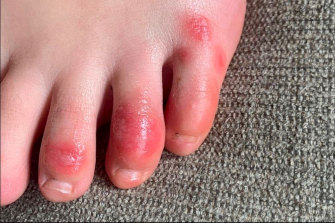‘COVID toe’ likely due to people not wearing socks in lockdown
For our free coronavirus pandemic coverage, learn more here.
London: The skin condition “COVID toes” may be a skin condition brought on by people not wearing socks in their homes during lockdowns and quarantine, scientists now believe.
Experts were puzzled during the pandemic when patients began reporting swelling and redness on their feet, with the condition lasting for months at a time.
Medical experts have questioned whether “COVID toe” was due to people not keeping warm while isolating at home.Credit: Aurora Daniels
Some researchers believed it could be a side-effect of the immune system overreacting in its response to fighting off the virus. But Yale University has a simpler solution: cold feet.
Researchers enrolled 23 people with suspected COVID toes into a study but only three were found to have had the virus.
Although the team said they could not rule out an immune response from an abortive infection, they said there were other explanations of how the pandemic could have triggered the rise in cases, such as people not wearing socks and shoes during winter months.
Discolouration on a teenage patient’s toes at the onset of the condition informally called “COVID toes”. Credit:AP
They also suggested that once COVID toes became a well-known phenomenon, people began to attribute their chilblains – skin soreness due to exposure to cold temperatures – to the condition.
Writing in the journal PNAS, the authors said: “An increased incidence of chilblains has been observed during the pandemic and attributed to viral infection. Our results do not support COVID-19 as the cause of the increased chilblain incidence.”
They said studies supported the explanation that COVID toes was caused by an increase in the incidence of chilblains. This could be attributed to altered behaviour during the pandemic, for example, not wearing socks or shoes at home during quarantine, or increased awareness owing to reports of COVID toes in the media.
Chilblains form after intermittent or prolonged exposure to cold or damp air. The cold air causes blood vessels near the skin’s surface to tighten or constrict, leading to decreased oxygenation and inflammation in these exposed areas.
The Telegraph, London
Most Viewed in World
From our partners
Source: Read Full Article

